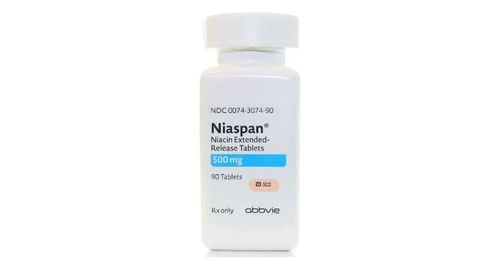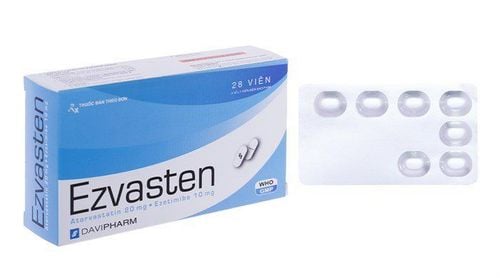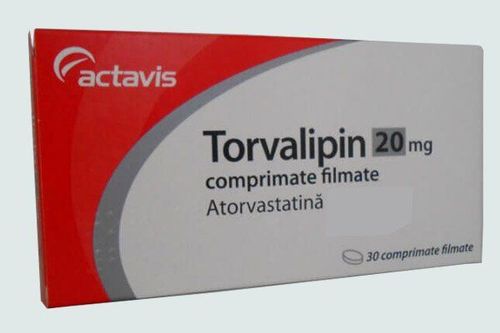This is an automatically translated article.
Sedentary lifestyle, unhealthy diet and overweight and obesity are the causes of increasing dyslipidemia. Dyslipidemia is a risk factor for many dangerous diseases such as coronary heart disease, ischemic heart disease, and stroke. Therefore, the careful and correct use of cholesterol-lowering drugs is an important issue that many patients are concerned about.
1. Types of cholesterol-lowering drugs and common side effects
1.1 Statin group Statins work by inhibiting HMG-CoA reductase, thereby preventing cholesterol creation in the liver and helping to lower blood cholesterol. In addition, drugs in the statin group also work to increase the number of receptors for LDL-cholesterol, thereby increasing the degradation and reducing LDL-cholesterol, the type of cholesterol that often causes atheroma to the lowest level. . At the same time, statins also increase HDL-cholesterol (good cholesterol). There are many drugs in the statin group with many different brand names, drugs in this class ending in "statin", including: simvastatin, atorvastatin, lovastatin, rosuvastain, pravastatin, fluvastatin.
Undesirable effects of statins include constipation, abdominal pain, increased liver enzymes, muscle pain. In addition, some patients also reported problems with cognitive disorders such as memory loss, confusion when taking statins.
1.2 Fibrate group Fibrate is a group of drugs used quite commonly in the treatment of blood lipids. The drug has the effect of lowering triglycerides, LDL and increasing HDL. Fibrates are usually indicated in patients with high triglyceride levels and high risk of acute pancreatitis. In people with hypertriglyceridemia and gout, fenofibrate has been shown to reduce blood uric acid with long-term use. The fibrate group includes drugs such as fenofibrate, ciprofibrate, bezafibrat...
Undesirable effects of the fibrate group are usually mild and vary from patient to patient. The drug is not suitable for patients with gallstones. Some side effects patients may experience when taking the drug such as nausea, abdominal pain, muscle pain, fatigue, muscle weakness. Fibrates may increase the effect of anticoagulants and increase the risk of myositis and myositis when used with statins.
1.3 Niacin group Niacin, also known as vitamin B3 - this is a water-soluble vitamin, has a good effect in the treatment of blood fat. Niacin inhibits the release of fatty acids from adipose tissue and inhibits the production of fatty acids and triglycerides by hepatocytes. The most common side effect was flushing, most pronounced in the head, neck, and upper body. Less common side effects include hypotension, diarrhea, aggravation of peptic ulcers, and liver dysfunction.
1.4 Renin group Drugs in this group include cholestyramine, colestipol... After oral administration, these drugs are not absorbed through the intestines and bind to bile acids, forming insoluble complexes that prevent bile acid reabsorption. This leads to increased synthesis of bile acids from cholesterol and lowers cholesterol. The drug is often used in combination with statins or in patients who are intolerant to statins. Should not be used in patients with very high triglycerides, as it may aggravate hypertriglyceridemia.
Some common side effects of this group are bloating, indigestion, heartburn, and constipation that limit adherence to medication. The drug also tends to reduce the absorption of some other drugs such as digoxin, warfarin, thyroxine,...
1.5 Inhibitors of cholesterol absorption An important drug in this class is ezetimibe. The drug has the ability to inhibit cholesterol transport and prevent cholesterol from the gastrointestinal tract. In addition, the drug can be used as monotherapy in patients with contraindications or intolerance to statins. The drug can also be used in combination with statins when patients cannot control LDL-cholesterol with statins alone.
Common side effects when taking ezetimibe are increased liver enzymes, joint pain, sinusitis, upper respiratory tract infection. Ezetimibe is contraindicated in patients with known hypersensitivity to the components of the drug, pregnant or lactating women, patients with liver disease if used with statins or with unexplained persistent elevations of liver enzymes.
1.6 Fish oil Omega-3 fatty acids such as DHA and EPA have a fairly strong triglyceride-lowering effect and moderate HDL-C increase. This drug is used in the treatment of high triglycerides and is often combined with a fibrates. An important side effect of this group is an increased risk of bleeding in patients taking antithrombotic drugs such as aspirin, warfarin. People who are allergic to fish or seafood should also be counseled about the possibility of drug allergies. Other common side effects include muscle pain, edema, and constipation.
2. When should blood cholesterol-lowering drugs be used?
Patients with mild dyslipidemia, no coronary artery disease, diabetes, non-smokers, hypertension, may not need medication. Patients can apply non-drug treatments such as diet and exercise... After 6 months of non-drug therapy according to the doctor's instructions, the blood lipid test results If there is still no improvement, the doctor may consider prescribing cholesterol-lowering medication to the patient. While taking the drug, patients still need to maintain a suitable diet and exercise to achieve the best lipid lowering. Patients should pay attention to limit eating animal fat and foods high in cholesterol, eat more fruits, vegetables, fiber and enough protein, exercise daily and lose weight if necessary.
Because there are many different groups of cholesterol-lowering drugs, depending on the patient, the doctor will prescribe the drug with the appropriate dose. The prescription depends on many factors including: blood cholesterol levels, medical conditions. other concomitants, the drugs being used to avoid drug interactions, tolerability of the patient. Blood cholesterol-lowering drugs can cause many side effects if used incorrectly by patients. Therefore, patients need to take cholesterol-lowering drugs exactly as directed by the doctor.
3. Notes when taking cholesterol-lowering drugs
There are many drugs that can interact with statin drugs, increasing the risk of side effects including: Amiodarone, cyclosporine, clarithromycin, itraconazole, gemfibrozil, saquinavir, ritonavir... Besides, some vitamins and herbs or supplements can also interact with statins. To limit drug interactions, patients need to inform their doctor about all drugs they have or are taking so that the doctor can advise on the appropriate use of drugs. Although cholesterol-lowering drugs are relatively safe, a notable side effect of statins and fibrates is rhabdomyolysis. This is a dangerous side effect due to the breakdown of skeletal muscle cells, releasing substances present in the cells, excreting myoglobin through the urinary tract and leading to urinary tract obstruction and kidney failure. The first signs of this side effect are muscle aches, weakness, muscle spasms (common in calf muscles, back muscles), followed by dark red urine. If the patient experiences the above symptoms, the patient should stop taking the drug and see a doctor immediately. During treatment with cholesterol-lowering drugs, patients still need to maintain an appropriate diet. Physical activity and weight loss if overweight or obese are good therapies to support drug treatment. Gemfibrozil and statins should not be used in combination because of the increased risk of myopathy. In summary, there are many classes of cholesterol-lowering drugs with different mechanisms of action. The doctor will choose the right drug depending on the cholesterol level in the blood, the comorbidities, the drugs being used to avoid drug interactions and the patient's tolerance. Cholesterol-lowering drugs can cause many side effects if used incorrectly by patients. Therefore, patients need to take cholesterol-lowering drugs exactly as directed by their doctor.
Follow Vinmec International General Hospital website to get more health, nutrition and beauty information to protect the health of yourself and your loved ones in your family.
Please dial HOTLINE for more information or register for an appointment HERE. Download MyVinmec app to make appointments faster and to manage your bookings easily.













